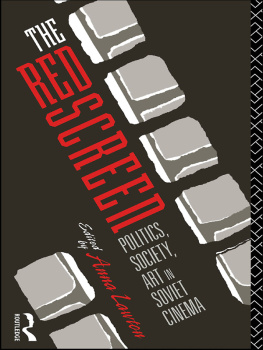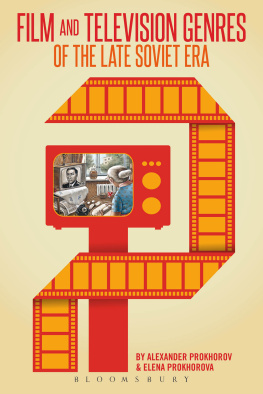
Marina L. Levitina teaches Russian Cinema at Trinity College Dublin. She is also a documentary filmmaker.
This is a book that sparkles with fresh insights and information. Marina L. Levitina has studied the impact of American films, actresses, and actors on Soviet authorities, critics, and the broad film-going public. The result is a novel and convincing reading of Soviet film and cultural politics in the 1920s and 1930s. The popularity of American films in the early Soviet era is well known but here readers will discover much that is new about the cultural interchange in the heyday of American imports and long afterwards as well. More fascinating still is her elucidation of the links between the pop culture of the American film industry and the officially promoted heroes and heroines of the Leninist-Stalinist social order. One can only say, well done. I recommend it highly for students and scholars alike.
Jeffrey Brooks, Johns Hopkins University, author of When Russia Learned to Read: Literacy and Popular Literature, 18611917
Professor Levitina has written an important new book on the dialogic or cross cultural interchange emerging among Soviet movie makers and the film industry centred in Hollywood. She conclusively demonstrates the paradoxical relation between the makers of a new Soviet culture and the imagery of American stars like Douglas Fairbanks and the techniques of montage created by directors like D. W. Griffith in America. The Soviets drew on Hollywood to create images of a new Soviet man and woman that their leaders hoped would stimulate Russians to embark on the road to modernity with its aspirations to energy, speed and willpower. Her book will provide a revelation to all readers interested in cinema, in world history and culture.
Lary May, Professor Emeritus, University of Minnesota, author of Screening Out the Past: The Birth of Mass Culture and the Motion Picture Industry
 In memory of my father
In memory of my fatherContents
Cinema has been the predominant art form of the first half of the twentieth century, at least in Europe and North America. Nowhere was this more apparent than in the former Soviet Union, where Lenins remark that of all the arts, cinema is the most important became a clich and where cinema attendances were until recently still among the highest in the world. In the age of mass politics Soviet cinema developed from a fragile but effective tool to gain support among the overwhelmingly illiterate peasant masses in the civil war that followed the October 1917 Revolution, through a welter of experimentation, into a mass weapon of propaganda through the entertainment that shaped the public image of the Soviet Union both at home and abroad for both elite and mass audiences and latterly into an instrument to expose the weaknesses of the past and present in the twin process of glasnost and perestroika. Now the national cinemas of the successor republics to the old USSR are encountering the same bewildering array of problems, from the trivial to the terminal, as are all the other ex-Soviet institutions.
Cinemas central position in Russian and Soviet cultural history and its unique combination of mass medium, art form and entertainment industry, have made it a continuing battlefield for conflicts of broader ideological and artistic significance, not only for Russia and the Soviet Union, but also for the world outside. The debates that raged in the 1920s about the relative merits of documentary as opposed to fiction film, of cinema as opposed to theatre or painting, or of the proper role of cinema in the forging of post-revolutionary Soviet culture and the shaping of the new Soviet man, have their echoes in current discussions about the role of cinema vis-`a-vis other art forms in effecting the cultural and psychological revolution in human consciousness necessitated by the processes of economic and political transformation of the former Soviet Union into modern democratic and industrial societies and states governed by the rule of law. Cinemas central position has also made it a vital instrument for scrutinising the blank pages of Russian and Soviet history and enabling the present generation to come to terms with its own past.
This series of books intends to examine Russian, Soviet and ex-Soviet films in the context of Russian, Soviet and ex-Soviet cinemas, and Russian, Soviet and ex-Soviet cinemas in the context of the political history of Russia, the Soviet Union, the post-Soviet space and the world at large. Within that framework the series, drawing its authors from both East and West, aims to cover a wide variety of topics and to employ a broad range of methodological approaches and presentational formats. Inevitably this will involve ploughing once again over old ground in order to re-examine received opinions but it principally means increasing the breadth and depth of our knowledge, finding new answers to old questions and, above all, raising new questions for further enquiry and new areas for further research.
The continuing aim of this series is to situate Russian, Soviet and ex-Soviet cinema in its proper historical and aesthetic context, both as a major cultural force and as a crucible for experimentation that is of central significance to the development of world cinema culture. Books in the series strive to combine the best of scholarship, past, present and future, with a style of writing that is accessible to a broad readership, whether that readerships primary interest lies in cinema or in political history.
Richard Taylor
Swansea, Wales
Transliteration from the Cyrillic to the Latin alphabet is a perennial problem for writers on Russian subjects. I have opted for a dual system: in the text I have used the Library of Congress system (without diacritics), but we have broken away from this system (a) when a Russian name has a clear English version (e.g. Maria instead of Mariia, Alexander instead of Aleksandr); (b) when a Russian name has an accepted English spelling, or when Russian names are of Germanic origin (e.g. Meyerhold instead of Meierkhold; Eisenstein instead of Eizenshtein); (c) when a Russian name ends in ii or yi, this is replaced by a single y (e.g. Dostoevsky) for a surname and a single i for a first name (e.g. Grigori, Sergei). In the scholarly apparatus I have adhered to the Library of Congress system (with diacritics) for the specialist.
I would like to thank Richard Taylor, for his invaluable insights, support and guidance during the work on this manuscript; Justin Doherty, for all his generous help throughout the years that this project took; Sarah Smyth, for the constructive criticism and encouragement at the times when I greatly needed it; Jane Taubman, for her insightful criticism; the film scholars at NIIK; the late Neia Zorkaia, for a helpful discussion early on; and Lisa Goodrum at I.B.Tauris.
I am very grateful to my mother, Ekaterina Levitina, for all her love and support; to my wonderful and kind husband, Colm Hogan, for his love, positivity and encouragement; and to Betsy and John Scarborough, for their kind and generous hearts and for helping me realize that Americans and Russians have a lot in common, as do human beings everywhere. And I am deeply grateful to my father, Leonid Levitin, for his love and belief in me, for his wisdom and sense of humour, and first-hand knowledge of 1930s culture.







 In memory of my father
In memory of my father